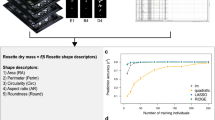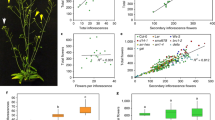Abstract
The flowers of strawberry plants grow on very variable branched structures called inflorescences, in which each branch gives rise to 0, 1, or 2 offspring branches. We extend previous modeling of the number of strawberry flowers at each individual level in the inflorescence structure conditional on the number of strawberry flowers at the previous level. We consider a range of logistic regression models, including models that incorporate inflorescence effects and random effects. The models can be used to summarize the overall structure of any particular variety and to indicate the main differences between varieties. For the data of the article, we show that models based on convolutions of correlated Bernoulli random variables outperform binomial regression models.
Similar content being viewed by others
References
Abramowitz, M., and Stegun, I. A. (1972), Handbook of Mathematical Functions, New York: Dover Publications.
Altham, P. M. E. (1976), “Discrete Variable Analysis for Individuals Grouped into Families,” Biometrika, 63, 263–269.
—(1978), “Two Generalizations of the Binomial Distribution,” Applied Statistics, 27, 162–167.
Bahadur, R. R. (1961), “A Representation of the Joint Distribution of Responses to n Dichotomous Items,” in Studies in Item Analysis and Prediction, ed. H. Salomon, Palo Alto, CA: Stanford University Press, pp. 158–176.
Brier, S. S. (1980), “Analysis of Contingency Tables Under Cluster Sampling,” Biometrika, 67, 591–596.
Cole, D. J. (2003), “Stochastic Branching Processes in Biology,” unpublished Ph.D. thesis, University of Kent, England.
Cole, D. J., Morgan, B. J. T., and Ridout, M. S. (2003), “Generalized Linear Mixed Models for Strawberry Inflorescence Data,” Statistical Modelling, 3, 273–290.
Cohen, J. E. (1976), “The Distribution of the Chi-Squared Statistic Under Clustered Sampling from Contingency Tables,” Journal of the American Statistical Association, 71, 665–670.
Dobson, A. J. (2002), An Introduction to Generalized Linear Models (2nd ed.), London: Chapman and Hall.
McCulloch, C. E., and Searle, S.R. (2001), Generalized, Linear, and Mixed Models, New York: Wiley.
Molenberghs, G. (2002), “Model Familes,” in Topics in Modelling Clustered Data, eds. M. Aerts, H. Geys, G. Moelenberghs, and L. M. Ryan, Boca Raton, FL: Chapman and Hall/CRC, pp. 47–75.
Ridout, M. S., Morgan, B. J. T., and Taylor, D. R. (1999), “Modelling Variability in the Branching Structure of Strawberry Inflorescences,” Applied Statistics, 48, 185–196.
Skellam, J. G. (1948), “A Probability Distribution Derived from the Binomial Distribution by Regarding the Probability of Success as Variable Between Sets of Trials,” Journal of the Royal Statistical Society, Series B, 10, 257–261.
Steele, B. M. (1996), “A Modified EM algorithm for Estimation in Generalized Mixed Models,” Biometrics, 52, 1295–1310.
Author information
Authors and Affiliations
Corresponding author
Rights and permissions
About this article
Cite this article
Cole, D.J., Morganp, B.J.T. & Ridout, M.S. Models for strawberry inflorescence data. JABES 10, 411 (2005). https://doi.org/10.1198/108571105X80761
Received:
Revised:
DOI: https://doi.org/10.1198/108571105X80761




